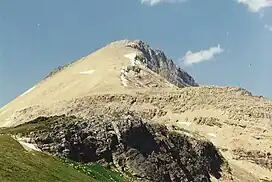| Cirque Peak | |
|---|---|
 Cirque Peak from Helen Lake, July 1994 | |
| Highest point | |
| Elevation | 2,993 m (9,820 ft)[1] |
| Prominence | 341 m (1,119 ft)[2] |
| Parent peak | Observation Peak[2] |
| Listing | Mountains of Alberta |
| Coordinates | 51°41′59″N 116°25′04″W / 51.69972°N 116.41778°W[2] |
| Geography | |
| Parent range | Canadian Rockies |
| Topo map | NTS 82N9 Hector Lake |
| Climbing | |
| First ascent | 1899[2][3] |
| Easiest route | Easy Scramble |
Cirque Peak is a 2,993-metre (9,820-foot) peak located directly west of Dolomite Pass in the Bow River valley of Banff National Park, in the Canadian Rockies of Alberta, Canada.
Scrambling Route
The scrambling route (rated easy) begins just beyond Helen Lake which can be reached by following the Helen Lake/Dolomite Pass trail 6 km from the trail head beside the Icefields Parkway. From the lake, follow the trail into Dolomite Pass and then choose a line up the peak.[5]
Geology
Like other mountains in Banff Park, Cirque Peak is composed of sedimentary rock laid down during the Precambrian to Jurassic periods.[6] Formed in shallow seas, this sedimentary rock was pushed east and over the top of younger rock during the Laramide orogeny.[7]
Climate
Based on the Köppen climate classification, Cirque Peak is located in a subarctic climate with cold, snowy winters, and mild summers.[8] Temperatures can drop below −20 °C with wind chill factors below −30 °C.
References
- ↑ Bow Lake and Saskatchewan Crossing (Map). 1:70,000. Gem Trek Publishing. 2000. ISBN 1-895526-10-8. Archived from the original on 2019-06-09. Retrieved 2019-06-08.
- 1 2 3 4 "Cirque Peak". Bivouac.com. Retrieved 2012-07-01.
- ↑ "Cirque Peak". cdnrockiesdatabases.ca. Retrieved 2019-06-08.
- ↑ Place-names of Alberta. Ottawa: Geographic Board of Canada. 1928. p. 34. Retrieved 2019-06-08.
- ↑ Kane, Alan (1999). "Cirque Peak". Scrambles in the Canadian Rockies. Calgary: Rocky Mountain Books. pp. 222–223. ISBN 0-921102-67-4.
- ↑ Belyea, Helen R. (1960). The Story of the Mountains in Banff National Park (PDF). parkscanadahistory.com (Report). Ottawa: Geological Survey of Canada. Archived (PDF) from the original on 2015-10-02. Retrieved 2019-09-13.
- ↑ Gadd, Ben (2008), Geology of the Rocky Mountains and Columbias
- ↑ Peel, M. C.; Finlayson, B. L. & McMahon, T. A. (2007). "Updated world map of the Köppen−Geiger climate classification". Hydrol. Earth Syst. Sci. 11: 1633–1644. ISSN 1027-5606.

